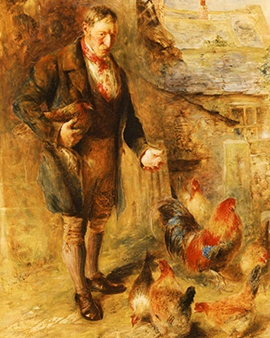William Huggins (1820-1884) was a British painter. The subject of his works of art were mainly animals. He owned a large number of pets. Huggins was born in Liverpool. He made his first attempts at drawing at the Liverpool Institute High School for Boys, where he won an art prize at the age of 15 with his painting Adam's Vision of the Death of Abel. The painting was subsequently exhibited at the Liverpool Academy of Arts. He then spent a lot of time at the Liverpool Zoo, Liverpool Zoological Gardens and Wombwell's Travelling Menagerie to study animals and then paint them. His work has often been compared to that of George Stubbs and Huggins readily admitted his influence. However, when he was compared to the painter Edwin Landseer, Huggins felt insulted. Stubbs and Landseer were both known for their animal paintings.
Huggins never traveled to faraway lands to see animals. Instead, he studied them in publications, travelling circuses and animal shows. Although his depictions of animals were praised, this circumstance meant that his background did not correspond to the natural environment of the animals. Huggins had never seen them in the wild. In particular, his use of colour stands out and has been widely praised. His use of glazes was due to his contact with the pre-Raphaelites. Besides exotic animals, he also drew horses, cattle and domestic fowl. The art historian Rupert Maas reports about Huggins that he was an eccentric personality who preferred the company of his domestic fowl to the company of humans. In 1845 he added literary themes to his repertoire, such as "The Faerie Queen" by Edmund Spenser. In 1846 his painting "Androcies and the lion" was exhibited at the Royal Academy of Arts. Up to the 70s he exhibited here repeatedly, but never became a full member of the Royal Academy. In the year 1861 he moved to his brother Samuel in Chester. Here he mainly painted buildings. His brother Chester was an author about arquitecture. Chester Huggins supported the restoration of Chester Cathedral, which William painted. After William Huggins moved to Betws-y-Coed in 1876, he mainly painted landscapes. In 1884 he died in the village of Christleton near Chester in Cheshire.
×





.jpg)
.jpg)
_-_(MeisterDrucke-237282).jpg)
_-_(MeisterDrucke-237282).jpg)
.jpg)
.jpg)
_-_(MeisterDrucke-1108573).jpg)
_-_(MeisterDrucke-1108573).jpg)
.jpg)
.jpg)
.jpg)
.jpg)
_1860_-_(MeisterDrucke-192598).jpg)
_1860_-_(MeisterDrucke-192598).jpg)
.jpg)
.jpg)
.jpg)
.jpg)
_-_(MeisterDrucke-195095).jpg)
_-_(MeisterDrucke-195095).jpg)
.jpg)
.jpg)
.jpg)
.jpg)
.jpg)
.jpg)
.jpg)
.jpg)
.jpg)
.jpg)
.jpg)
.jpg)
.jpg)
.jpg)
.jpg)
.jpg)
.jpg)
.jpg)
.jpg)
.jpg)
_-_(MeisterDrucke-172117).jpg)
_-_(MeisterDrucke-172117).jpg)
.jpg)
.jpg)
.jpg)
.jpg)
.jpg)
.jpg)
.jpg)
.jpg)
.jpg)
.jpg)
.jpg)
.jpg)
.jpg)
.jpg)
.jpg)
.jpg)
.jpg)
.jpg)
.jpg)
.jpg)
.jpg)
.jpg)
.jpg)
.jpg)
.jpg)
.jpg)
.jpg)
.jpg)
.jpg)
.jpg)
.jpg)
.jpg)
_-_(MeisterDrucke-1119059).jpg)
_-_(MeisterDrucke-1119059).jpg)
.jpg)
.jpg)
.jpg)
.jpg)
.jpg)
.jpg)
.jpg)
.jpg)
_-_(MeisterDrucke-298679).jpg)
_-_(MeisterDrucke-298679).jpg)
.jpg)
.jpg)
.jpg)
.jpg)
.jpg)
.jpg)
.jpg)
.jpg)
.jpg)
.jpg)
.jpg)
.jpg)
.jpg)
.jpg)






